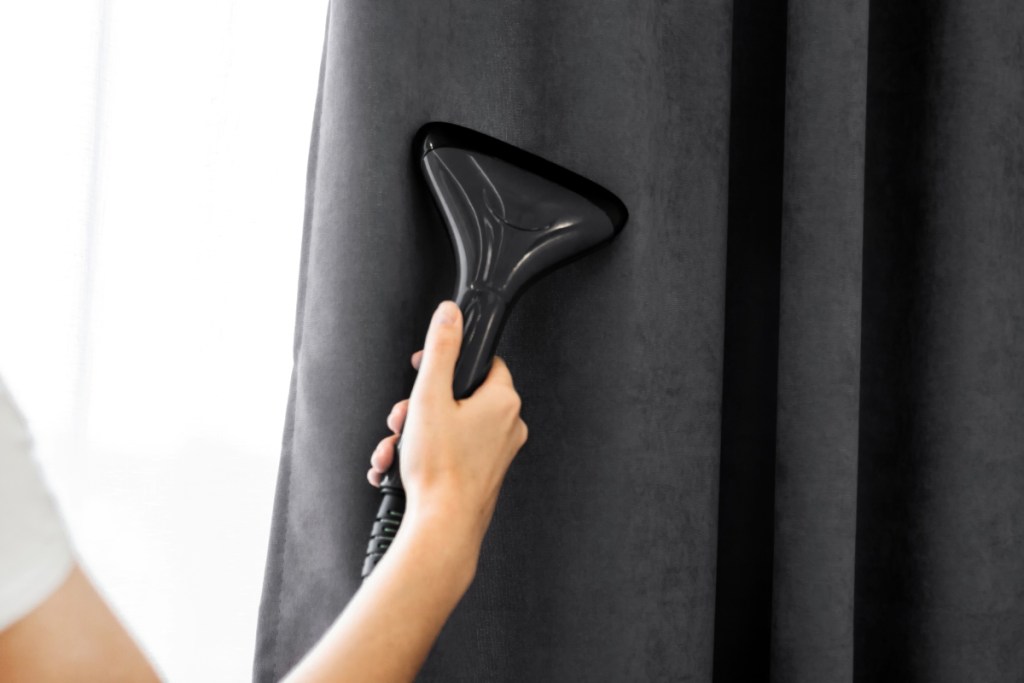Your curtains and draperies play a significant role in your home, protecting you from harsh sunlight and adding sophistication to your space. Unfortunately, your curtains also collect dandruff, dust, dirt, and other allergens that can cause mild to severe health issues for any inhabitants.
To keep your space clean, stick with us as we guide you through the best practices for cleaning curtains so you can keep your home dust and allergen-free.
How often should you clean your curtains?
Depending on your curtain’s material, you may have to clean them more often. Pet hair, dust, dirt, and other small particles can easily collect on your curtains. However, a quick swipe of a lint roller once a week and a light dusting during your household cleaning routine can keep your curtains in check.
Sometimes these drapes need a little more TLC. Every three to six months, it’s time for a deep clean.

Best practices for making your curtains last longer
First, it’s essential to check the labels and read over the manufacturer’s instructions for cleaning the curtains. Depending on the brand and material, you may need to wash them by hand, throw them in the machine, or send them to the dry cleaners.
Regardless of what the instructions say, checking for colorfastness can prevent the color from bleeding during the cleaning. Simply fill a small glass with warm water and a few drops of mild detergent. Find a hidden corner on your draperies and dip it into the glass. If the color bleeds, you will have to take the curtains to a professional cleaner.
You may also need to take a trip to the cleaners if you have delicate or expensive trimmings. Try to avoid regular dry cleaners as they may not have the right experience to clean them properly.
Last, to keep your curtains up to par, dust often. Vacuum or dust the rods and shake the fabric to release any hidden dirt in the folds.
Materials and tools
- Washing machine and dryer (optional when following curtain care instructions)
- Large sink, tub, or basin
- Mild dish detergent (for hand washing)
- Mild laundry detergent (for machine washing)
- Iron and ironing materials

How to clean cotton curtains
Cotton curtains are low maintenance, so the cleaning process is quick and simple.
Treat stains
Cotton fabrics are easily stained, so check your curtains often and treat them with a fabric stain remover as quickly as you can.
Wash on a gentle cycle
Wash your curtains one at a time to allow them ample space in the machine. Use a gentle or delicate setting with cold water and a mild laundry detergent.
Dry on a low-heat setting
Once washed, place your cotton curtains into a machine dryer on a low heat setting. Allow the draperies to dry until they are just damp but not wet. If they dry completely in the machine, you’ll be left with tons of wrinkles in your curtains.
Iron while damp
While your cotton curtains are still damp, grab the iron. To prevent searing, use a pressing cloth and iron on the backside. As soon as you’re finished, hang up the curtains to air-dry.
How to clean sheer curtains
Sheer and lace fabrics need more attention than other materials, so these curtains will need more frequent cleaning to stave off any discoloration and tearing.
Let the fabric soak in cold water
Fill your tub or basin with cold water and place your sheer curtains inside so that they are entirely covered. Add a small amount of mild laundry detergent and soak the fabric for five to ten minutes.
Wash on a gentle cycle
If the instruction label permits it, wash your sheer curtains on a gentle cycle with mild laundry detergent. Otherwise, hand wash the fabric with mild dish detergent.
Dry and hang
Once washed, place your sheer curtains in a machine dryer and set it to a no-heat air-dry setting. Place some cloth towels in the dryer alongside the sheer curtains to prevent them from balling up and losing their shape.
While they are still damp, hang your curtains up on the rod, reshape them, and allow them to air-dry.

How to clean silk curtains
Silk is a delicate fabric to work with, so it’s best to hand wash this material.
Hand wash
Fill a basin or tub with lukewarm water and mix in some mild dish detergent. Place the silk curtains in the soapy water and work the fabric so that the detergent saturates the material. After washing, rinse the curtains in lukewarm water until there are no more suds.
Place the fabric on a dry towel and roll the curtain up in the towel to remove excess water.
Let them air dry
Hang your curtains indoors to air dry. Avoid placing the silk curtains near a heat source or vent, as doing so can damage the fabric.
Iron while damp
If necessary, iron your silk while it is still damp. Set your iron to a silk-specific or low setting, and gentlly iron the curtains from the backside. Use a pressing cloth to protect the fabric and prevent water stains.
How to clean room-darkening and synthetic drapes or curtains
Most synthetic drapes can withstand a cycle in a standard washer or dryer. If the instruction label states otherwise, opt for hand washing or take the curtains to a professional cleaner.
Wash in cold water
If you have curtains of multiple colors, separate them into piles of lights and darks to avoid color bleeding. Set your washing machine to a cold, gentle cycle, and add a mild laundry detergent. Avoid using any bleach, as this could ruin the fabric.
Set the dryer to tumble
Dry the synthetic or blackout curtains on a low to medium heat setting and let the fabrics tumble dry. As soon as they’re dry, hang them on the rods to prevent wrinkles.
Caring for your curtains is not difficult, but it is important to follow the label instructions and prevent damage. Clean curtains keep your home fresh and dust-free so you can enjoy your relaxation time without allergen-induced coughing and sneezing.
Editors' Recommendations
- How to clean oven racks the easy way
- How to hang curtains: A complete guide
- Do you need to wash walls before painting? The honest truth
- Avoid a huge fire risk in your home: How to clean your dryer vent
- How to clean glass shower doors the right way (say goodbye to streaks)



